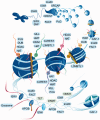EpiFactors: a comprehensive database of human epigenetic factors and complexes
- PMID: 26153137
- PMCID: PMC4494013
- DOI: 10.1093/database/bav067
EpiFactors: a comprehensive database of human epigenetic factors and complexes
Abstract
Epigenetics refers to stable and long-term alterations of cellular traits that are not caused by changes in the DNA sequence per se. Rather, covalent modifications of DNA and histones affect gene expression and genome stability via proteins that recognize and act upon such modifications. Many enzymes that catalyse epigenetic modifications or are critical for enzymatic complexes have been discovered, and this is encouraging investigators to study the role of these proteins in diverse normal and pathological processes. Rapidly growing knowledge in the area has resulted in the need for a resource that compiles, organizes and presents curated information to the researchers in an easily accessible and user-friendly form. Here we present EpiFactors, a manually curated database providing information about epigenetic regulators, their complexes, targets and products. EpiFactors contains information on 815 proteins, including 95 histones and protamines. For 789 of these genes, we include expressions values across several samples, in particular a collection of 458 human primary cell samples (for approximately 200 cell types, in many cases from three individual donors), covering most mammalian cell steady states, 255 different cancer cell lines (representing approximately 150 cancer subtypes) and 134 human postmortem tissues. Expression values were obtained by the FANTOM5 consortium using Cap Analysis of Gene Expression technique. EpiFactors also contains information on 69 protein complexes that are involved in epigenetic regulation. The resource is practical for a wide range of users, including biologists, pharmacologists and clinicians.
© The Author(s) 2015. Published by Oxford University Press.
Figures


References
-
- Jaenisch R., Bird A. (2003) Epigenetic regulation of gene expression: how the genome integrates intrinsic and environmental signals. Nat. Genet., 33 Suppl, 245–254. - PubMed
-
- Tomazou E.M., Meissner A. (2010) Epigenetic regulation of pluripotency. Adv. Exp. Med. Biol., 695, 26–40. - PubMed
-
- Miller C.A., Sweatt J.D. (2007) Covalent modification of DNA regulates memory formation. Neuron, 53, 857–869. - PubMed
Publication types
MeSH terms
Substances
LinkOut - more resources
Full Text Sources
Other Literature Sources
Miscellaneous

